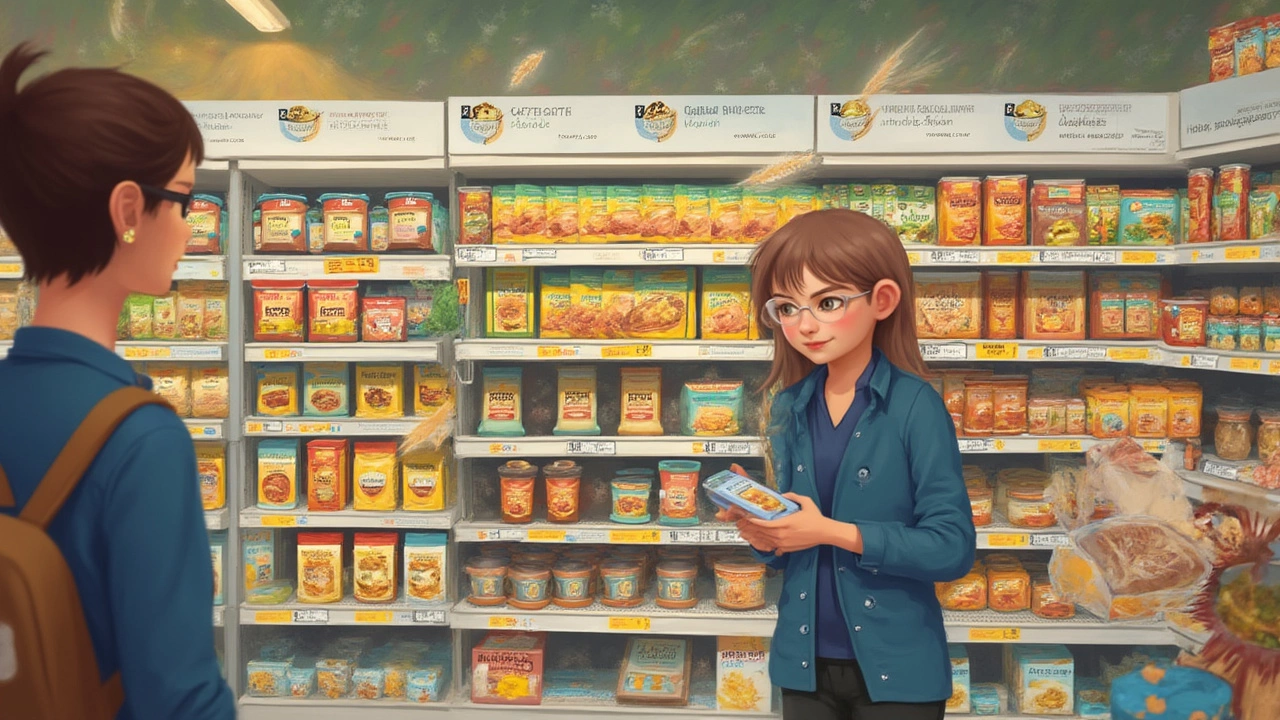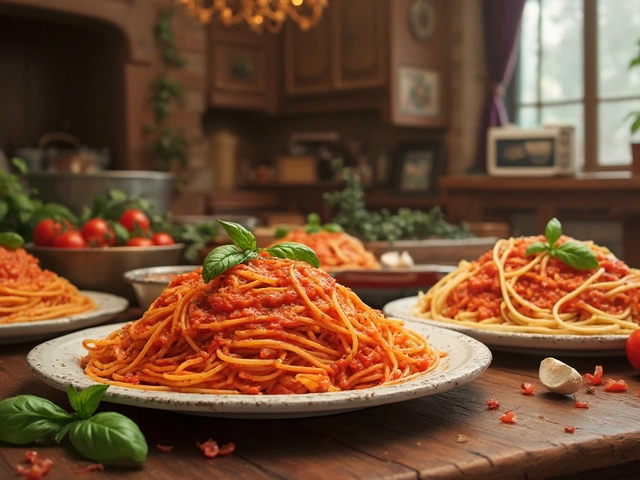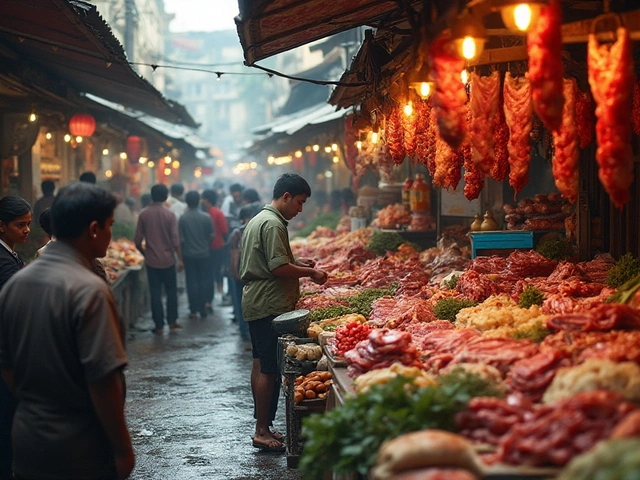
The next time you reach for a french fry or grab a pack of gum, you might want to think twice—your so-called 'safe' snack could be packing gluten right under your nose. It's easy to assume gluten just hangs out in bread or pasta, but this sticky little protein is a master of hide-and-seek. You keep a sharp eye out for wheat, barley, and rye, but gluten has all sorts of disguises. How does it sneak its way into foods you’d swear were gluten-free? A slip of malt here, a pat of soy sauce there—tiny bits that can add up to a big problem if you’re celiac or sensitive. Ready to find out which foods may flip your gluten radar on its head?
How Gluten Hides in Unexpected Places
If you follow a gluten-free diet, it's easy to mistrust a croissant, but salad dressing? Seasoned fries? Ever wonder how gluten gets in these? The answer lies in food processing quirks and sneaky ingredients that manufacturers love. Hydrolized wheat protein, malt extract, brewer's yeast, and modified food starch from wheat can show up in places you'd never expect.
Take soy sauce—sounds innocent, right? But the most common types rely on wheat as a base. You have to hunt for tamari or specialty gluten-free soy sauces if you want to keep wheat out of your stir fry. The same goes for those beautiful golden fries at your favorite diner. Some restaurants dust them with seasoning mixes that contain wheat flour, or they fry them in the same oil as battered foods.
What's really wild: some shredded cheeses use anti-caking agents that may be wheat-based. Even oats, naturally gluten-free, almost always get contaminated with gluten during processing unless the package states they're "certified gluten-free." Figuring all this out takes some serious label detective work. And it's not just food—medications, vitamins, and even toothpaste can slip in traces of gluten as binders or flavorings.
Why do companies do this? Cost and texture, mostly. Gluten acts as a binder, giving food a satisfying chew or holding it together. In processed foods, it can pop up in the shape of malt vinegar, caramel coloring (less often now, but still a risk), or as part of pre-made sauces and gravies. Decades ago, nobody thought twice about tossing a scoop of wheat flour into a pot of soup to thicken it, and some traditions have stuck.
Common Foods That Unexpectedly Contain Gluten
Let’s get real and break down some specific foods where gluten lurks. Here’s a hard-hitting list of popular items that trip people up:
- French fries: Unless made in a dedicated fryer, they often share oil with breaded nuggets or onion rings.
- Imitation crab (surimi): That “krab” in sushi? Usually bound with wheat starch.
- Pickles: Sometimes marinated with malt vinegar instead of distilled (safe) vinegar.
- Soy sauce: Like we mentioned, standard soy sauce contains wheat.
- Salad dressings and marinades: Wheat starch or malt flavoring is sometimes used for texture or taste.
- Licorice and chewy candies: Wheat flour gives them that stretchy texture.
- Processed lunch meats: Gluten can show up in fillers, spices, or as a binder.
- Energy bars and granola bars: Barley malt syrup and wheat germ can hide here.
- Hot chocolate mixes: Malted milk powder is a common culprit.
- Egg substitutes: Occasionally thickened with wheat-based stabilizers.
This isn’t just trivia. For people with celiac disease, accidentally eating gluten even in tiny amounts can damage the small intestine and trigger a whole mess of symptoms—anything from stomach pain to brain fog. Even for those who just feel better on a gluten-free diet, these sneaky sources can be frustrating. That’s why reading labels is still king.
If you think it’s getting easier to avoid gluten, you’re right—sort of. Food labeling laws in the U.S., Canada, and Europe have tightened, making it more obvious when wheat, barley, or rye are present. But not every country follows the same rules, and some loopholes remain. Take "natural flavors"—legally, that's a vague term. Unless a company clarifies, you might not know where that flavor originated.

Hidden Gluten in Everyday Drinks and Condiments
Think your drink is safe? You’d be surprised. Certain beers, unless labeled as gluten-free, start with barley malt. The same goes for malt beverages: hard lemonades or wine coolers often begin life with barley before getting loaded with fruity flavors. Spirits like whiskey or gin get trickier. Technically, distillation should remove gluten, but many people with celiac are still sensitive to traces—or to added flavors after the fact.
Here’s something that blows people’s minds: some coffee syrups and instant coffee mixes have hidden thickeners that might be wheat-based. Oat milk is another one, especially those not certified safe, since they're prone to cross-contact with gluten-rich grains during bottling.
On the condiment front, watch for gluten popping up as malt vinegar in ketchup, or in certain mustards that use wheat flour as a stabilizer. Even barbecue and teriyaki sauces can be iffy—many traditional recipes rely heavily on soy sauce or malt extracts to pack that deep umami punch. Any salad dressing that’s creamy or has “crunchy” bits like croutons or chunky cheese mixes is suspect.
Some surprising drinks and condiments that have or may have gluten:
- Flavored or pre-mixed hot chocolate powders
- Pre-made smoothie mixes
- Malt powder in milkshakes
- Some flavored vodkas or liqueurs
- Commercial gravy or seasoning packets
- Bouillon cubes and stock bases (especially those with “hydrolyzed wheat protein”)
Ever brushed your teeth and gotten sick later? Gluten can be in toothpaste flavors, too, though it’s rare. Bottom line: ask questions, especially when you travel, since brands and recipes change from country to country.
How to Spot Gluten on Ingredient Labels
Staring at a label and not seeing "wheat" doesn’t mean you're in the clear. Gluten can slide in under all sorts of different names, many of which sound perfectly safe unless you know what to look for. Here’s a cheat sheet for scanning the shelves:
- Barley: Shows up as malt, malt vinegar, malt extract, or malt syrup.
- Rye: Mostly just in rye bread or whiskey, but sometimes in flavorings.
- Wheat: Besides “wheat,” look for triticale, spelt, semolina, farina, farro, or durum.
- Hydrolyzed or modified food starch: If wheat-based, this will usually be listed—unless you’re outside of strict labeling countries.
- Brewer’s yeast: Often left over from beer-making, usually not safe.
Companies use tricky terms. “Natural flavors,” “vegetable protein,” “textured vegetable protein,” and “spices” can sometimes hide gluten-based fillers. If you’re ever unsure, hopping online to the manufacturer’s website or picking up the phone will usually get you a yes or no.
Check out the table below for common gluten terms on labels:
| Ingredient Name | Contains Gluten? |
|---|---|
| Malt extract | Yes (from barley) |
| Hydrolyzed wheat protein | Yes |
| Malted milk powder | Yes |
| Oats* | Risky (unless labeled gluten-free) |
| Rice starch | No |
| Corn starch | No |
| Soy lecithin | No |
| Distilled vinegar | No (unless malt-based) |
*Oats are only safe if labeled “gluten-free.”
It’s a pain, but the more you scan labels, the more obvious the clues get. A tip for eating out: always ask your server about sauces, seasoning mixes, and fried foods. If you’re at a deli or bakery, double-check on lunch meats, spreads, and even seemingly innocent salad bar items like olives (sometimes tossed with bread crumbs or wheat-based oils).

Tips for Living Gluten-Free (Without Losing Your Mind)
Having to ask a million questions or Google every new snack gets old fast. Here are some tips to help you stick with it while still enjoying food:
- Stick to naturally gluten free foods: plain veggies, fruits, rice, fish, meats, eggs, dairy, nuts, and seeds.
- Look for certified gluten-free labels, especially on oats, snacks, and processed foods.
- Join a local or online group—other gluten-free folks can point out minefields in your area.
- Traveling? Bring gluten-free snacks just in case, and learn the words for “gluten” and “wheat” in the local language.
- Cook more at home: You’ll always know what goes in your food, and there’s way less risk of cross-contamination.
- Use a smartphone app to scan barcodes for gluten—these have gotten super accurate in the last couple of years.
- When in doubt, reach out to the manufacturer for the latest info. Recipes change more often than you’d expect.
- Keep it simple when dining out. Grilled chicken and salad beats a “safe” pasta made with mystery sauce.
- Be careful with bulk bins in grocery stores. Scoops move between wheat flour and rice, so contamination runs high.
It can feel overwhelming at first, but you’ll pick up the lingo fast—the key is to stay curious, ask questions, and check labels, always. If you slip up, don’t beat yourself up. Most people with celiac or gluten sensitivity have a learning curve and a few accidental exposures along the way.
It might seem like gluten is out to get you, but with a little know-how, you can eat like a king and avoid those hidden gotchas. Who knew that something as simple as soy sauce or French fries could be a gluten minefield? Trust your gut (literally)—and don’t be afraid to dig a little deeper every time you sit down to eat.





